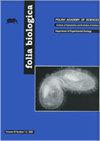Is the blue-spotted phenotype more widespread in the eastern slow worm Anguis colchica (Nordmann, 1840) than the western slow worm Anguis fragilis Linnaeus, 1758 and does it correlate with the male body size? A case study from Central Europe
IF 0.8
4区 生物学
Q4 BIOLOGY
引用次数: 0
Abstract
The blue-spotted phenotype in a slow worm can be considered as an alternative colour morph or a secondary sexual characteristic. This phenotype is known to entail an elevated predation risk; thus, its continuous presence in a population must be balanced by additional and positive fitness consequences. In this study, we show that blue-spotted males are characterised by a greater snout-vent length (SVL) than typical specimens. Importantly, the SVL of blue-spotted males reaches the magnitude of the average female size. This indicates that the presence of blue spots may involve a correlated positive effect on growth and body size. The greater body size of the blue-spotted males could enhance their survival and mating success, and thus facilitate the continued presence of a high fraction of this morph within the population. In addition, we found that the blue-spotted phenotype is more common in the eastern than the western slow worm, and the proposed fitness consequences of the blue-spotted phenotype might enhance its tendency to spread in the eastern Anguis lineage.东部慢虫angis colchica (Nordmann, 1840)的蓝斑表型是否比西部慢虫Anguis fragilis Linnaeus(1758)的蓝斑表型更为普遍?这是否与雄性体型有关?中欧的一个案例研究
慢虫的蓝斑表型可以被认为是一种替代的颜色变体或第二性征。已知这种表型导致捕食风险升高;因此,它在人群中的持续存在必须与额外的积极适应结果相平衡。在这项研究中,我们发现蓝斑雄性的特征是比典型标本的口鼻部通气口长度(SVL)更大。重要的是,蓝色斑点雄性的SVL达到了雌性平均体型的大小。这表明蓝色斑点的存在可能对生长和体型产生相关的积极影响。蓝斑雄性体型越大,可以提高它们的生存率和交配成功率,从而有助于在种群中继续存在大量这种变体。此外,我们发现蓝色斑点表型在东部比西部慢虫更常见,并且蓝色斑点表型的适应性结果可能会增强其在东部安格斯谱系中传播的趋势。
本文章由计算机程序翻译,如有差异,请以英文原文为准。
求助全文
约1分钟内获得全文
求助全文
来源期刊

Folia Biologica-Krakow
医学-生物学
CiteScore
1.10
自引率
14.30%
发文量
15
审稿时长
>12 weeks
期刊介绍:
Folia Biologica (Kraków) is an international online open access journal accepting original scientific articles on various aspects of zoology: phylogeny, genetics, chromosomal studies, ecology, biogeography, experimental zoology and ultrastructural studies. The language of publication is English, articles are assembled in four issues per year.
 求助内容:
求助内容: 应助结果提醒方式:
应助结果提醒方式:


